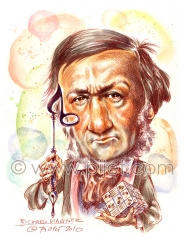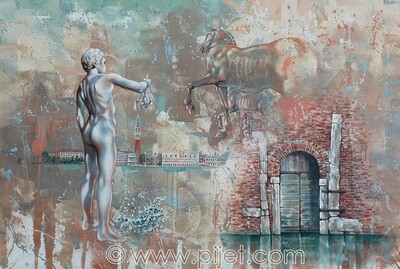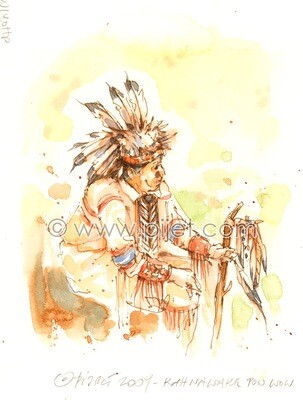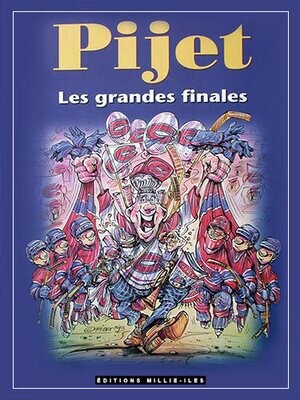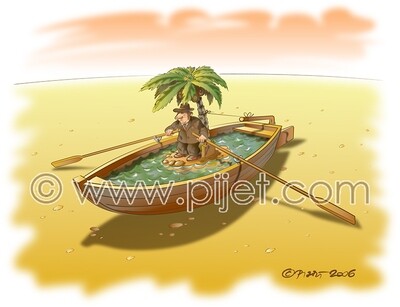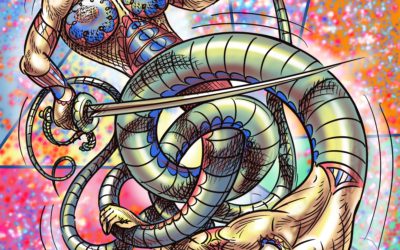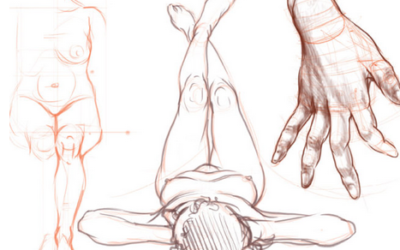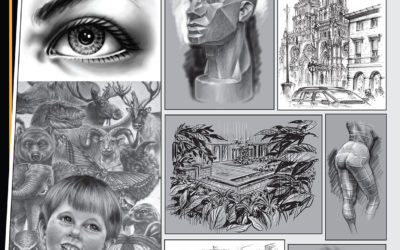I. Introduction.
How does satirical art foster knowledge and visual literacy and why should it be taught?
I would like to respond to this question by creating a series of satirical artworks through intrinsic content which I would propagate knowledge about “how to” and “why to,” by implementing critical thoughts on comprehensive humorous ways as an educational endeavor. It will be a journey through which I will be able to teach and at the same time learn about how I perceive and extrapolate knowledge through the lenses of satirical visual commentary. The question I pose, and to which I intend to respond, have a solid base concerning many years of my experience as a practicing artist and caricaturist. My satirical artworks have been published in many different newspapers, journals, magazines, books, catalogues, and advertising publications in many countries. I would like to share the experience I have collected from many years by teaching, which could benefit students who are interested in the art of satirical drawing, and caricature as an educational tool.
Since my early childhood I have been surrounded by satirical art and caricatures, which I had a chance to explore in a massive collection of various reviews, albums, catalogues, and books, which were stored in my uncle’s studio and served him as references for his paintings. I was lucky enough to have easy access to such a great “encyclopedia” of all kinds of satirical art. The satirical imagery stimulated my learning about the world I was about to experience. This constant exposure to visual material created in my mind a desire to become an artist who would be able, as my uncle was, to express his feelings and observations through the visual language of satire and humor. Furthermore, during many of my professional activities such as: caricature animations, participation in many international festivals of caricature and press drawing, I have seen mostly the happy and smiling faces of the many people who were participating in these events with great excitement. It is why I think that satirical art could play an important role in education curricula by teaching students to create an intellectually resourceful and challenging art, which would explore their sense of critical thinking and humoristic regard on a variety of important issues to which our contemporary society is exposed on a daily basis. My professional experiences taught me that many times satirical art is misunderstood because the viewer lacks knowledge about the represented subject. The art of caricature teaches visual literacy like no other form of art does. It needs to be explained here I am discussing satirical art and caricature according to my standards, that narrative can be formed through the means of metaphorical imagery and without any captions present, which could play a role of a leading (meta) narrative. In consequence, my concept of caricature and satirical art excludes any form of drawing where the editorial role is to serve rather as an illustration to the published text instead of standing on its own visual narrative. The combination of text and drawing degrades significantly the artist’s visual story and exposes the limits of his creativity and attaches a label of commerciality to his work. The caricaturist practices a form of visual journalism and his language of communication with the public represents his ability to express his comments through the cognitive symbolism of the creatively composed imagery. In such a way the caricaturist provokes the viewer to active thinking, educative curiosity, and affords the deciphering and reflecting critically on the visual narrative as a form of invitation to an intellectual conversation with the viewer. An image, of which the only purpose is to illustrate the text, belongs to a different category of humoristic expression, which is the illustrated comics and cartooning gags, where all is explained and in consequence the deductive and reasoning faculty of the viewer is limited or non-existent. In such cases the narrative of the image is imposed on the viewer rather than proposed to him/her for cognitive deduction and visual contemplation. It is why most of the important international competitions of caricature and satirical art do not accept drawings with captions from the participants. It is an unfortunate fact that in general the understanding of the art of caricature and satirical drawings and all these important nuances are ignored, and that all forms of humoristic creativity are collected under the one umbrella of caricature and cartooning. So far, to my knowledge, no one has tried to distinguish between these various forms of satirical art. Meanwhile, it is important to do so in order to bring about respect and recognition to this form of artistic creativity, and at the same time to eradicate the generalized stigma of commerciality and lowbrow art that is attached to this form of art by the “fine art” world. The word caricature has a generalized meaning and is a representation of a kind of deformation of reality, not only portraiture, but also other realities represented metaphorically in a satirical way. The caricaturist creates his/her artwork in the same process of cognitive reflection and an aesthetic sensation as any other artist does. The only difference is that he involves a deeper deductive voice and sense of elaborated observation permitting the viewer to see how much the surrounding reality is changed. The criteria of the art of caricature and satire, which I have already described in the text above, belongs theoretically to the category of fine arts as a form of artistic expression. It is an unfortunate fact that most of the theoretical ruminations on the subject of commerciality do not take into consideration the fact that there is no art, which is in one-way or another not commercial. The artist is always expecting either to be paid for his creation or to be supported to practice it by various promoters and organizations, what basically results in the same. At the end of the process in research for artistic sustainability the financial aspect dominating the role is always present and necessary for the art to survive.
The art of caricature and satirical expression has an important advantage over other artistic forms of expression. It is generating knowledge as a form of social pedagogy and it is an important reason for why it needs be taught.
II. Procedure.
Satirical drawing and caricature are omnipresent futures in today’s contemporary reality. The distorted faces of politicians, actors, musicians, sportsmen, and the various characters and situations that make the news serve as a great source of creative inspiration for artists who “speak” and “tell” their stories through the burlesque character of their imagery. The humoristic perception of reality is contained in an imagery that provokes joy and anger. It all depends from which angle the images are looked at. These particular forms of visual communication, of content or discontent, have accompanied societies since the very beginning of humanity.
The satirical perception surrounding our realities has been always present, in one way or another, and documented in various artistic creative forms throughout the ages of our human existence. To support such an argument one needs to look closely at the artifacts, which we have inherited from our ancestors. We can start reviewing this heritage from as early as 30.000 years BC (the oldest artifacts so far) which includes objects such as the statue of the Venus of Willendorf, the caricatured engravings of faces from the caves at Le Marche; the satirical situations depicted on the cave rocks at Lascaux in France, Egyptian wall paintings and engravings, Greek satirical sculptures and pottery paintings, Pompeian caricature graffiti, medieval sculptures on Gothic cathedrals, Renaissance caricatures and satirical paintings, followed by Baroque, Rococo, and all other artistic styles, which basically evolved and nourished creatively one another to the present day. The significant amount of artworks left to us by each epoch could be theorized through the means of the epistemological approach to it and as such can be adopted for educational purposes in the exploration of the art of caricature and satirical perception of the past as well as the present. Reflecting on the amount of visual materials, which are available to us for studies, it seems that the human race has always had the faculty and desire to express their satirical commentary through the means of humoristic exaggerations in regard to their respective realities.
The contemporary art world reduced the art of caricature to a lower category of artistic practice, mostly due to the label of commerciality, which is attached to this extraordinary form of art by a hierarchical attitude within contemporary artistic circles. In such cases the artists who express themselves through the means of satirical artworks “can only say what they have to say, the trouble is not with their work but those who, having eyes see not, and having ears, hear not” (Dewey, 2005, p.108-109). Meanwhile, it is an art form, which is the perfect tool for communication among the arts, and arts based research practices. Satirical art is a tool, which promotes visual literacy by provoking the spectator to think and understand what is presented to them in the form of a visual dialogue. The process of drawing caricature or composing satirical paintings generates all the necessary aspects of arts based research actions such as reflection, interrogation, conversation, deliberation, and debates (Barone & Eisner, 2012, p. 59).
The creation of satirical art consists of an intelligent distortion of reality, which allows the artist to explore the subject through the means of symbolic and elaborated narratives connected to various figurative forms juxtaposed in a comprehensive unity via the process of cognitive observation. Satirical art demands from an artist to possess a wide spectrum of general knowledge, and the ability to know how it can be implemented in the creative process in order to communicate the desired intrinsic narrative. Satirical art is an “art” which “thinks” (Critchley, 2009) and provokes others to think too. “It is the image of thought that guides the creation of concept” (Deleuze, 1995, p. 148), and as such can and should be explored in arts based research practice.
III. Abbreviated Review of Literature.
Arnheim, Rudolf (1974). Art and Visual Perception-a Psychology of the Creative Eye. Los Angeles, CA: University of California Press.
Rudolf Arnheim (1974), in his book, reflects on various issues regarding visual perception and creativity. The author elaborates in his text on various psychological aspects regarding image creation and is trying to explain how an image is conceived and how its content is affecting the viewer’s perception of it. Arnheim theorizes about cognitive concepts of visual imagery by leading the reader through the genealogy of understanding various narrative aspects of an artist’s pictorial mind. He reflects also on the art of caricature as a particular creative endeavor.
Baridon, Laurent, & Guédron, Martial (2009). L’art et l’histoire de la caricature. Paris, France: Éditions Citadelles & Mazenod.
Baridon and Guédron in their publication present an elaborately conducted historical research on the art of caricature. This monumental and indispensable book leads the reader through a massive bank of information about the development of caricature through the history of humanity. The authors concentrate their efforts mostly on French artists and mention only the most well known caricaturists from England, Italy, Spain, and other countries. However, it is an important and very well researched source of information about the origins of caricature and satirical art.
Champfleury- Fleury-Husson, Jules François Felix (1865). Histoire de la caricature antique. Paris, France: Dentu, E. Éditeur-Librarie de la Société des gens de lettres, Palais Royale, Galerie d’Orléans.
Champfleury was one of the first to write an extended and well-researched history on caricature and satirical art. This position of Champfleury is the first of four volumes written by the author on the subject of antic caricature. It is an important source of information about the early, mostly sculptural, satirical art of Assyrians, Egyptians, Greeks, and Romans. Furthermore, Champfleury has collected many different descriptions and theories regarding the art of caricature from various scholars, writers, artists, historians, and philosophers. The other three volumes in this series explore the history of caricature and satirical art during the medieval, renaissance, and baroque periods. The last book covers the history of satirical art development during the first half of the nineteenth century.
Deregowski, J. B. (1984). Distortion in Art-The Eye and the Mind. New York, USA: Routledge Kegan & Paul.
Deregowski in his book explores various forms of “deformations” existing in art in general, including the art of caricature. The author elaborates on the ambiguities found in distorted imagery and their psychological effects on a viewer. The author proposes to the reader a literary voyage through the human minds ability to perceive visually and elaborates on the various artifacts and their pictorial alterations, which can be found by studying the history of art. According to Deregowski, each distorted image emanates with its own philosophy of historic narrative waiting for the viewer’s deductive exploration. Through the deformation of reality each image attracts our cognitive attention towards it.
Gombrich, E. H. & Kris, Ernst (1938). The Principles of Caricature. British Journal of Medical Psychology, 17, 319-42.
Gombrich and Kris, in their essay, review the history of satirical art and caricature in relation to the various epochs of western art development. The article is a section within a much more elaborated historical study on the subject of caricature, which the authors conducted for the purpose to publish their conclusions in a form of a book. Unfortunately, according to the information available, the project was never commercialized. However, the text, which is available, brings an interesting light on the way the art of caricature was practiced through the centuries of artistic development in western society. The authors, review earlier information collected by Champfleury (1865) and Wright (1875) on the subject of caricature and its first appearance as early as in antiquity.
Gombrich, E. H. (1982). The Image and the Eye: Further Studies in the Psychology of Pictorial Representation. New York, USA: Cornell/Phaidon Books. Cornell University Press.
Gombrich explores in his book a variety of concepts and writings about the art of painting and portraiture, including his thoughts on the art of caricature and satirical creativity. The author reflects on the different viewpoints of the visual perceptions, which are available to the viewer’s contemplative mind, through the pictorial representations of the artists’ illusory creative realities. Gombrich proposes to the reader well researched content, which is the perfect tool for the exploration and reflection on the multiple faces of the psychology of artistic creativity through the history of pictorial art.
Klausen, Jytte (2009). The Cartoons That Shook the World. New Haven, USA: Yale University Press.
Klausen investigates in her book the controversy surrounding the Danish cartoons on the twelve caricatures of the Prophet Muhammad. These caricatures were published by a local journal, and in resulted in provoking an incontrollable set of events contrasting two opposite socio-cultural entities. The Danish case shows how important it is to foster knowledge and visual literacy in order to avoid similar conflicts in the future. The book’s content shows how it is important to propagate pictorial liberty through an appropriate education about the visual democracy of the free artistic expression, a freedom that is omnipresent and particular to western culture.
Parton, James (1877). Caricature and Other Comic Art in All Times and Many Lands. New York, USA: Harper & Brothers Publishers.
Parton, in his book, collected multiple data about the art of caricature and satirical production from various cultural regions of the world. Regardless of his intentions, most of the books content focuses mostly on French and English historical developments of satirical art and caricature. It is an interesting collection of different facts, which were earlier researched by Champfleury. However, Parton represents his own perceptive analysis of satirical art and caricature.
Porter, Robert (2009). Chapter 2: Painting. In Deleuze and Guattari: Aesthetics and Politics. Cardiff, England: University of Wales Press.
Porter, in his relatively new book, reflects on Deleuze’s philosophical elaborations concerning the question of what is artistic creativity, what is an idea and how it is developing, especially in the domain of painting. To Deleuze the art of painting provokes in the mind of the viewer a set of visual sensations. The Deleuzeian concept of sensation can be easily adapted to the art of caricature and satirical drawing and painting. These forms of creative activity share the same visual dilemma, which is the psychological impact related to the effects provoked by distorted realities. The Deleuzeian philosophical reflections will play an important inspirational and theoretical role during my Visual Arts-Based Research Project.
Wright, Thomas (1875). A History of Caricature and Grotesque in Literature and Art. London, England: Chatto and Windus, Piccadilly.
Wright’s book represents an English version of Champfeury’s research on the subject of caricature. Wright reflects on satirical art and caricature through the wide spectrum of historical and cultural events. He offers his own historical vision of the development of satirical art and caricature and the book contains a lot of illustrations.
These abbreviated reviews of the literature represent just a fragment of my theoretical resources, which will be used to support my research project.
IV. Conclusions.
Satirical art and the art of caricature play an important role as the social barometer of healthy socio-political and cultural coexistence. It is a sign of a strong society where freedom is not restrained by any dogmatic influences or political demagogies. Furthermore, the art of caricature is an excellent tool to encourage the growth of imagination and promote its creative development through the process of satirical drawing practice. “Humor may encourage a process of education wherein the receiver is given a chance to adjust the distorted image…” “We should therefore look more closely into the humorous parts of the caricature” (Saeverot, 2011, p. 92). To teach how to use satirical art in education opens yet another entry in the process of helping students to learn how to read the visual content and how it could be logically applied to various issues, regarding contemporary society, which could be approached pedagogically by fostering the culture of humor. Through the means of humor we can approach any delicate and controversial issue if we know “how to.” Teaching through visual satire is also educating about the socio-political and culture of “savoir vivre,” which in our case could be rephrased as “savoir penser” and “savoir rire.” Satirical art cultivates open-minded responsible individuals who are conscious of the complexity of various social issues. The art of caricature and satire propagates not only creative knowledge but also democratic literacy. It teaches people to laugh intelligently and to distance themselves from low quality jokes. The issue of quality exists as much in satirical art as in any other artistic creative expression. It is why I think that teaching the art of caricature and satirical art is an intelligent pedagogical approach that will benefit everyone. Furthermore, satirical art and caricature has the ability to explore new horizons of knowledge in Art Education research practice.
V. Bibliography
Arnheim, Rudolf (1974). Art and Visual Perception-a Psychology of the Creative Eye. Los Angeles, CA: University of California Press.
Baridon, Laurent, and Martial Guédron (2006). L’art et l’histoire de la Caricature. Paris,
France: Éditions Citadelles & Mazenod.
Barone, Tom, & Eisner, Elliot W. (2012). Arts Based Research. Los Angeles, CA: Sage.
Boundas, Constantin, V. (Ed.), (1993). Part IV, Chapter 22: Painting and Sensation. In The Deleuze Reader. New York, USA: Columbia University Press.
Champfleury, Jules (1867). Histoire de la caricature Antique. Paris, France: Libraire de la Société des gens de lettres.
Champfleury, Jules (1876). Histoire de la caricature au Moyen Age et sous Renaissance. Paris, France: Libraire de la Société des gens de lettres.
Critchley, Simon (2009). Scenes from a Marriage: Have Art and Theory Drifted Apart?
Retrieved from:
http://www.friezefoundation.org/talks/detail/scenes_from_a_marriage_have_art_and_theory_drifted_apart/
Deleuze, Gilles (1995). Chapter: Life as a Work of Art. In Negotiations, 1972¬–1990. New York, NY: Columbia University Press.
Deleuze, Gilles & Guattari, Félix (1987). A Thousand Plateaus-Capitalism and Schizophrenia. Minneapolis, MN: University of Minnesota Press.
Deregowski, J. B. (1984). Distortion in Art-The Eye and the Mind. New York, USA: Routledge Kegan & Paul.
Desbarats, Peter, and Terry Mosher (1979). The Hecklers. Toronto, Canada: The
Canadian Publishers McClelland and Stewart Limited.
Dewey, John (2005). Art as Experience. New York, NY: Perigee.
Duccini, Hélène (2001, March). La Caricature-deux siècles de dérision salutaire. Historia, 651(3), 46-78.
Ferrance, Eileen (2000). Action Research. Providence, RI: Brown University.
Gombrich, E. H. & Kris, Ernst (1938). The Principles of Caricature. British Journal of Medical Psychology, 17(38), 319-342.
Gombrich, E. H. (1960). Art and Illusion: A Study in the Psychology of Pictorial Representation. New York, USA: Pantheon Books Inc.
Gombrich, E. H. (1982). The Image and the Eye-Further Studies in the Psychology of Pictorial Representation. New York, USA: Cornell/Phaidon Books. Cornell University Press.
Horn, Maurice (Ed.), (1980). The World Encyclopedia of Cartoons. New York, NY: Chelsea House Publishers.
Klausen, Jytte (2009). The Cartoons that Shook the World. New Haven, USA :Yale University Press.
McNiff, Shaun (2008). Chapter 3. Art-Based Research. In Knowles, Gary J. & Ardra L. Cole (Eds.), Handbook of the Arts in Qualitative Research (p. 29). Thousand Oaks, CA: Sage Publications.
McNiff, Jean (2002). Action Research for Professional Development-Concise Advise for New Action Researchers. (3rd ed.). Retrieved from: http://www.jeanmcniff.com/ar-booklet.asp
Parton, James (1877). Caricature and Other Comic Art in All Times and Many Lands. New York, USA: Harper & Brothers Publishers.
Porter, Robert (2009). Chapter 2: Painting. In Deleuze and Guattari: Aesthetics and Politics. Cardiff, England: University of Wales Press.
Saeverot, Herner (2011). Rhetorical Caricature: An Educational Reading of Nabokov’s Treatment of Freud. Phenomenology & Practice, 5(1), 84-99. Retrieved from
http://www.phandpr.org/index.php/pandp/article/view/80
Streicher, Lawrence, H. (1965). David Low and the Sociology of Caricature. Comparative Studies in Society and History, 8(1), 1-23. Retrieved from http://0www.jstor.org.mercury.concordia.ca/stable/177533
Sullivan, Graeme (2010). Art Practice as Research-Inquiry in Visual Arts. Thousand Oaks, CA: SAGE Publications, Inc.
Wright, Thomas (1875). A History of Caricature and Grotesque in Literature and Art. London, England: Chatto and Windus.

